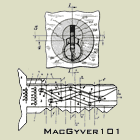|
Information about locks themselves. Questions, tips and lock diagram information should be posted here.
 by MacGyver101 » 18 Jul 2006 17:29 by MacGyver101 » 18 Jul 2006 17:29
greyman wrote:I still don't quite understand how EVVA gets two polarities, one on each side of the key, that are not just magnetic opposites. Any info on this much appreciated.
While the magnets themselves (in terms of field strength and durability) are impressive, the actual mangetic arrangement is reasonably straight-forward. Picture, if you will, a standard bar magnet; if you've played with magents and iron filings, you've undoubtedly seen pictures like this:
http://commons.wikimedia.org/wiki/Image:Magnet0873.png
These bar magnets typically have a "North" and a "South" end. Cutting bits off the end of a bar magnet will eventually leave you with a square -- but one end of the square would sill be "North", and the other would still be "South". If you then round off the corners of the square, you will have a small disc... with one "North" edge and one "South" edge. You could then rotate the disc and have the "North" edge face in different directions: this is, in essence, how the discs are arranged on the keys... and how they end up with something more complicated than a key combination like "North-North-South-North-South".
I hope that helps... 
-

MacGyver101
- Moderator Emeritus
-
- Posts: 1560
- Joined: 21 Jun 2006 14:40
- Location: Toronto, Canada
 by mh » 18 Jul 2006 17:34 by mh » 18 Jul 2006 17:34
The thing is though, the rotation of the magnetic field is different on either side of the key. And I'm told that they are not just 2 magnets glued together, but that it's one round element. (4 of those in one key)
That seems difficult to achieve to me.
Cheers,
mh
"The techs discovered that German locks were particularly difficult" - Robert Wallace, H. Keith Melton w. Henry R. Schlesinger, Spycraft: The secret history of the CIA's spytechs from communism to Al-Qaeda (New York: Dutton, 2008), p. 210
-
mh
- Moderator
-
- Posts: 2440
- Joined: 3 Mar 2006 4:32
- Location: Germany
-
 by MacGyver101 » 18 Jul 2006 17:43 by MacGyver101 » 18 Jul 2006 17:43
mh wrote:. . . the rotation of the magnetic field is different on either side of the key. And I'm told that they are not just 2 magnets glued together . . .
Hrm... my understanding may very well be wrong, then. I would certainly agree with you: that domain arrangement would seem very difficult to achieve in one single magnet (or, rather, in one single magnet that wouldn't slowly demagnitize itself...)
If anyone has any more information on this, I, too, would be very interested... 
-

MacGyver101
- Moderator Emeritus
-
- Posts: 1560
- Joined: 21 Jun 2006 14:40
- Location: Toronto, Canada
 by n2oah » 18 Jul 2006 18:52 by n2oah » 18 Jul 2006 18:52
mh wrote:The thing is though, the rotation of the magnetic field is different on either side of the key. And I'm told that they are not just 2 magnets glued together, but that it's one round element. (4 of those in one key)
That seems difficult to achieve to me.
Cheers,
mh
Staraight from LSS:
"This will allow eight different field orientations per magnet, or8^8 permutations."
"Evva and Ikon use a process that allows them to magnetize each of
the discs with eight distinct orientations, much like a piece of
pie sliced into eight sections."
In the illustrations, it looks like there is not one big magnet, but I'll look into it further. "Lockpicking is what robbing is all about!" says Jim King.
-
n2oah
-
- Posts: 3180
- Joined: 13 May 2005 22:03
- Location: Menomonie, WI, USA
-
Return to Locks
Who is online
Users browsing this forum: No registered users and 3 guests
|




